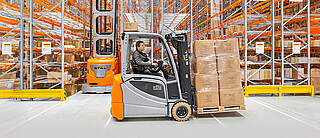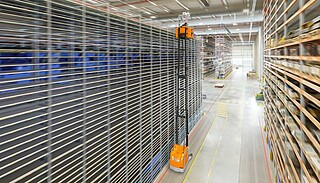3PL under pressure: Logistics service providers need flexible solutions

In an industry in which every cent counts for logistics orders and many customers only sign two-year contracts, logistics service providers themselves need strong partners who can provide them with a fleet that is as flexible as possible and support them with user-friendly software and effective automation.
"Logistics? Works for us! Thanks to 3PL". Companies that use third-party logistics (3PL) - that is, outsource their entire logistics operations to service providers - rely on flawless processes. Yet making this work in the face of increasing cost and time pressures and a persistent shortage of skilled labour remains a major challenge and business risk for logistics service providers.
In the "Whitepaper on logistics service providers: Definition and trends", STILL lists the current trends and challenges for logistics service providers, describes possible solutions and presents suitable truck technology and customised services for the 3PL sector. The good news: despite short contract terms and changing requirements, it is possible to make long-term, sustainable investments. With the scalable solutions outlined in the whitepaper, logistics service providers are well prepared. This applies to both the fleet and the software.

The right industrial trucks for every logistics job
From an economic standpoint, it makes no sense - nor is it feasible given the diversity of orders - for 3PLs to purchase all types of forklift trucks, pallet trucks and order pickers. Many rely on leasing or rental models. However, those looking to rent forklift trucks should look carefully when choosing a partner, because service makes all the difference! Key benefits include cross-regional availability, flexible changes to the equipment mix, short-term provision of additional vehicles for order peaks as well as fast maintenance and repair.
Skilled labour shortage: Fleet without drivers?
So, you have a modern and flexible fleet, but where are the drivers? Logistics service providers need to be prepared for the fact that the shortage of skilled labour will not only continue but will increase as many experienced warehouse logistics specialists and forklift drivers retire in the coming years. This makes it all the more important not to lose employees to competitors, but to retain them in the company by offering attractive working conditions. This includes ergonomically designed, individually adaptable industrial trucks with a high level of operating comfort to minimise physical strain, as well as intuitive software and smart safety and assistance systems.

Assistance systems are also becoming all the more important when logistics service providers have to work with less qualified staff due to the shortage of skilled labour. Where there is a lack of experience and possibly also language skills, smart technology reduces the risk of errors and accidents. The 3PL sector is already looking for intelligent solutions to handle peaks in demand with fewer staff and to fulfil logistics assignments for a wide range of goods and batch sizes.
This can be achieved with greater efficiency – of course! But so that this magic word does not go up in smoke, STILL presents tangible solutions for increasing efficiency in the 3PL whitepaper and encourages logistics service providers to (partially) automate. This investment is worthwhile even for logistics service providers with very short contract terms if they identify processes that are similar for many customers. One example is the transport of empty pallets, which can be safely handled by automated guided vehicles (AGVs).
Ever higher – but safe!
Of course, efficiency must never come at the expense of safety, and this is especially true in warehouses with very high racking. Logistics service providers should only use trucks designed for the relevant lift heights and, where possible, equipped with stability monitoring systems. These enable fast, accurate and safe storage and retrieval at height.

Assisted vertical picking
The trend in order picking also favours space-saving vertical storage. This is an additional challenge at the most complex stage of the logistics chain, where there is still limited scope for automation. Product variety and small batch sizes, as well as long distances and high time pressure, place an enormous burden on order pickers. Vertical order pickers and digital process optimisation make their work easier - even on two levels.
Read the "STILL Whitepaper on Logistics Service Providers: Definition and Trends" to find out how the right trucks, smart technology and flexible services can be used to efficiently manage logistics orders from delivery to the warehouse to the last mile.
Contact request
Subscribe to the Newsletter !
Always up to date with STILL: Subscribe to the STILL newsletter and we will inform you regularly about interesting industry topics.
